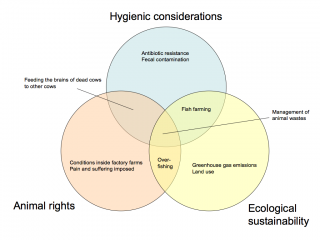During the last few days, a number of people have asked about the reasons for which I am a vegetarian. As shown in the Venn diagram above, my reasons fall into three major clusters:
- Hygienic concerns
- Animal rights concerns
- Ecological concerns
Basically, the first category applies if you only think about your own immediate well being. If you are willing to consider the possibility that it is wrong to treat some animals in some ways, considerations in the orange circle start to apply. If you accept that we have general duties to preserve nature (or recognize that our long term survival depends on acting that way), issues in the yellow circle are of concern.
The specific issues listed are just examples. They are not exhaustive representations of all the problems in each area. Possible reasons for being vegetarian also exist outside these areas: for example, you can think it is wrong to eat meat when the grain used to fatten the animals could have alleviated the hunger of other humans.
A few issues are unambiguously in one area – for instance, the de-beaking of chickens is almost exclusively an ethical problem. The fact that no experimental laboratory could get ethical approval to treat their test subject animals in the way factory farmed animals are treated as a matter of course is telling. Some overlaps are ambiguous. Overfishing destroys the habitats of species I consider us to bear moral duties towards (such as whales and dolphins), even if the fish themselves can be legitimately used as means to whatever ends we have.
Naturally, different kinds of meat and processes of meat production do more or less well in each area. For my own sake, I think each of the three areas is sufficient in itself to justify vegetarianism. It is possible to imagine meat production that doesn’t have any of these problems, but it is an extreme rarity today and my appreciation for meat is not strong enough to justify the cost and effort of seeking it out. That said, I would be much happier if people who were going to consume meat made such choices, instead of helping to perpetuate the machinery of modern industrial farming.
Related prior posts:









